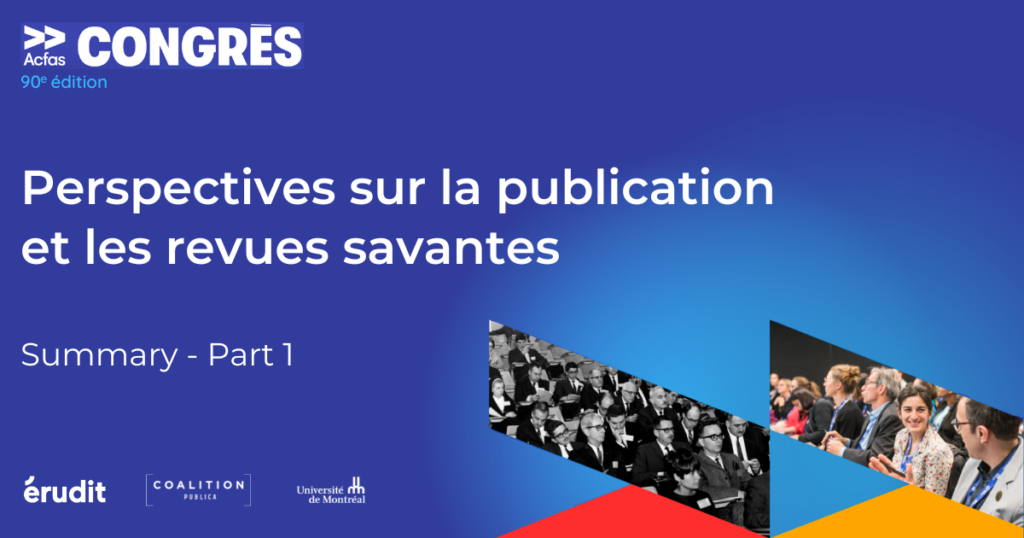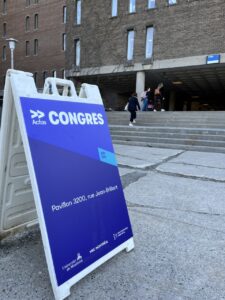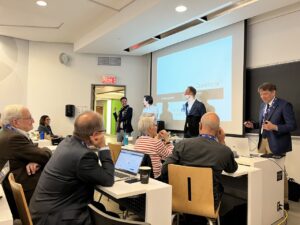
This conference, titled Perspectives sur la publication et les revues savantes : évolution du libre accès, des pratiques d’évaluation et des nouvelles possibilités de recherche (Perspectives on Publishing and Scholarly Journals: Evolution of Open Access, Evaluation Practices and New Research Possibilities) was held on May 11 and 12, 2023, as part of the Annual Conference of the Acfas. Journals took centre stage during those two days, which saw gathered a large number of stakeholders from the world of scholarly publishing in Quebec, Canada and abroad.
Should Scholarly Publishing Be Profitable?
Working from the archives of Philosophical Transactions, a British journal founded in 1665, Aileen Fyfe (University of St Andrews) presented a timeline of the funding methods for one of the oldest scholarly journals in the world. This work showed that early scholarly publications gave priority to their reach, with profitability as a secondary concern. Beginning in 1752, when the Royal Society took editorial control of the journal, the finances of Philosophical Transactions became dependent on the finances of the Society, in the form of memberships and income from investments made possible by its endowment. This model remained dominant for over 200 years, and it was only at the end of the 19th century that a governmental subsidy was added to its revenue stream. In the 1920s, funding from the Royal Society was supplemented with private and corporate donations, notably an annual contribution by Imperial Chemical Industries. The fourth significant transformation came in the post-War period, which saw the emergence of commercial for-profit journals, creating a context where scholarly publishing became a financially viable business. The British Society revised its priorities, shifting from readership to profitability. In 1954, these changes, associated with the automation of typesetting, made Transactions a source of revenue for the Royal Society. From then to the dawn of the 21st century, revenue from journal sales increased, while the number of issues being sold declined. Thus, when the Royal Society moved the journal into open access, begrudgingly at first, it put an end to a business model that had been in place for 70 of the journal’s 350-year history.
Link to the presentation

The current generalization of open access does require that we grapple with the question of journal funding, an issue that was put forth in the presentations of Mikael Laakso (Hanken School of Economics), Leigh-Ann Butler and Stefanie Haustein (Université d’Ottawa), as well as Marc-André Simard (Université de Montréal).
Mikael Laakso presented a study titled European scholarly journals from small—and mid-size publishers: mapping journals and public funding mechanisms, in which he maps out the existing public funding mechanisms which benefit European scholarly journals tied to relatively small publishers. The situation in Europe being fragmented and contrasted, this study is an invitation to gather more complementary data on public funding mechanisms for European journals, funding which often occurs at the university level. Around 25% of open access journals have article processing charges (APC), but those vary between smaller publishing houses and larger commercial publishers, whose APCs are notably higher. His presentation proposed dividing forms of government support for journals into four categories, ranging from the most structuring support, in the form of Inclusive government subsidies allocated to all peer-reviewed journals (Finland, Spain), to the absence of any form of funding in countries such as the UK, Germany, the Netherlands and Greece. As for the category covering support given out by competition, granting periods vary from one to three years, which creates instability, especially as these programs generally come with an array of requirements relating to open access. For diamond open access to become the norm, other forms of funding are necessary if journals are to do more than simply survive. Diamond open access is the fairest model of open access as there are no costs for both authors, who do not have to overcome the financial obstacle of APCs, and readers, who have access to every article without paying a subscription or a per-article fee. Similarly, more support should be given to infrastructure that helps pool resources and services.
Link to the presentation
At the other end of the spectrum from diamond open access are for-profit forms of open access, notably proposed by the five main multinational commercial publishing corporations (Elsevier, Sage, Springer-Nature, Taylor & Francis and Wiley). Leigh-Ann Butler and Stefanie Haustein gave a detailed overview of the issues created by these commercial models, notably their Transformative Agreements. This refers to agreements between these main commercial publishers and academic institutions, often library consortiums, who pay a flat fee so that their members can access journals owned by these publishers, as well as get published in them. Consequently, library budgets and research grants, which come from public funds, are funnelled into commercial activities, rather than helping to broaden access to research. Transformative agreements also divert publishable manuscripts toward journals controlled by the largest commercial publishers. These agreements, which are nominally supposed to generalize open access, do not include clear commitments from the publishers and could be labeled new “Big Deals,” a practice that had played a key role in the “periodical crisis” where university libraries saw their budgets drained by subscription agreements with these multinational corporations. Data shows that APCs amount globally to a bit over a billion dollars a year, with profit margins of around 30%.
Link to the presentation
Butler and Haustein highlighted that these commercial open access models tend to maintain already stark inequalities in scientific publishing, a problem that has also been remarked upon by Marc-André Simard. His presentation showed how, over the last four years, developed countries have been massively investing in open access, a transition funded primarily by APCs and transformative agreements. This source of funding excludes certain groups of researchers, especially those who are early career scholars and therefore cannot afford the APCs. These practices also incentivize researchers to publish in international journals, often belonging to multinational corporations, even when dissemination infrastructures exist within the researcher’s home country. In Quebec and Canada for example, 98% of articles available on erudit.org are in open access. His study also confirms that diamond open access model leaves more room for a plurality of languages than the gold model (30% in English versus 75% for gold open access journals), which fits with the historical domination of English in commercial publications. Finally, while the APC route is consistently put forward in conversation about the sustainability and affordability of open access publishing, the figures show that the vast majority (71%) of open access journals are funded without article processing fees, indicating that diamond open access is not only a fair, but also realistic approach.
Link to the presentation
The Prescriptive Power of Research Evaluation Practices

The current function of scholarly publishing goes beyond the dissemination of knowledge and academic work, it also acts as an instrument for evaluating and prioritizing, practices which are omnipresent in contemporary research. The current issues with scholarly communication are thus intertwined with a paradigm of research evaluation, and consequently, of researchers evaluation.
Juan Pablo Alperin (Simon Fraser University) raised this question by considering practices in Latin America, and more specifically in Columbia. At the very end of the 20th century, the core concerns in the world of scholarly publishing were labeled “visibility” and “quality,” which gave rise to two simultaneous, but divergent responses. On one hand, this period saw the development of several regional indexing initiatives, with the creation of Latindex, SciELO, Redalyc and LA Referencia, which were associated with the adoption of (diamond) open access, the pooling of resources and the creation of regional criteria for editorial quality. However, it was also marked by the intensification of “international” criteria when it came to the quality of scientific articles, namely visibility metrics based on the indexing of journals in commercial databases such as the Web of Science or Scopus and quality metrics through the Journal Impact Factor (JIF), as well as other quantitative metrics based on citations. And so, while very interesting, regional initiatives were in constant tension with practices arising primarily from the world of for-profit publishing. The power of these practices were such that they washed out the effects of legislation in support of open access which has been passed in several Latin American countries in the last few years, to the point of making the impact of such laws barely noticeable in the data. Projects for reforming research evaluation methods, which are underway in some of these countries, face a steep challenge, and will require committed collective action to succeed.
Link to the presentation
The tension between the local anchoring of journals covering social sciences and the humanities and the transnational logic of scholarly publishing was at the heart of Simon van Bellen’s (Érudit Consortium) presentation, which examined the role played by national journals covering these fields in Canada. In Canada, there are around 600 scholarly journals in the humanities, the social sciences, the arts and literature, most of which are led by small editorial teams. They are also usually affiliated with a university and are not for profit. An important first observation to emphasize is that articles published in these journals are four times as likely to be in open access compared to articles published in commercial journals covering equivalent fields. They conform, for the most part, to a diamond open access model, which is truly accessible and fair as they are not charging APCs. Collected data also shows that these journals are prime vectors of dissemination for research covering Canadian issues, which are substantially less covered in commercial journals based outside Canada. Notably, these journals create a space for the publication of French-language articles, thereby feeding the bibliodiversity of scholarly publishing. When they collaborate with English-speaking colleagues in Canada, French-speaking researchers are much less likely to publish in French. Even more strikingly, this applies to articles borne of international collaborations, even between French speakers, who still mainly choose to publish in English. This move to English probably reflects a desire to reach international research networks which raises the question of how to reconcile the incentives to internationalize and the importance of publishing in French.
Link to the presentation
For his part, Vincent Larivière (Université de Montréal) focused on the relevance of peer review, an omnipresent aspect of the scientific process. The practice as it is known today emerged in the early 1940s, notably as a response to an increase in the number of submitted manuscripts and the specialization of research methods, two changes that made it harder for journal editors to be “experts” in every field. Nowadays, peer review exists mainly in four modalities: single blind (the author’s name is public, but not the evaluator’s), double-blind (both are anonymous), open (both are public) and post-publication, a more recent practice that takes the form of comments included after the publication of the article. Peer review is generally considered the unavoidable stamp of quality for scholarly publications even though the practice presents numerous shortcomings, starting with the burden it creates for researchers, and the sometimes very lengthy publication times it can create. Moreover, it does not always fulfill this quality assurance role as the evaluation is often done without access to the raw data, and studies have shown that the process cannot detect errors and frauds. On top of biases, which often hinder people who are also already the most socially marginalized, and even intimidation or inappropriate comments, this practice does not put a stop to back-scratching and conflicts of interest, as the number of possible evaluators does tend to be limited. Even more fundamentally, it has also been shown that this practice has a conservative tendency, which reinforces already established “normal science,” at the expense of newly emerging ideas.
Link to the presentation
Textual Data Corpora and Their Potential for Research

Articles published by journals constitute considerable collections which, when digitized, become corpora of textual data which can in turn be objects of research and exploration, notably through computer-assisted methods of data mining.
Bilingual data corpora can be used to train automatic translation tools, which are undergoing booming development, as Susanna Fiorini (OPERAS) has pointed out, also noting that it might be more accurate to speak of “computer-assisted scientific translation.” Since the Helsinki Initiative on multilingualism in scholarly communication in 2019, several projects pertaining to translation have been developed, including the creation of a first working group, named Translations and Open Science, and the launch of four exploratory studies covering the various possible aspects of deploying translation technologies for scholarly publishing. Automatic translation has several possible uses, such as informative, “on the fly” translation for readers, support for writing and translating for researchers, translation support tools for professional translators, and a boost to discoverability for multilingual science. Automatic translation does, however, present legal, technical and ethical challenges. The legal challenges relate notably to translation rights tied to licenses. Collecting and creating a quality corpus, integrating automatic translation and maintaining the quality of translation engines are among the technical challenges encountered. Ethical concerns include the recognition of the work and professional expertise of translators, who are required to create quality bilingual corpora and who risk being simply exploited during this automation process.
Link to the presentation
The research done by Jean-Guy Meunier (Université du Québec à Montréal) has relied for a long time on computer-assisted methods for analyzing philosophical texts. The project he presented rests on the hypothesis that a part of Quebec culture is marked by the development of the practice of philosophy, particularly outside academia. The objective was to identify and study this philosophical heritage as it exists in texts. One of the difficulties encountered in such studies is that, outside of scholarly journal articles, there are few textual corpora which have been digitized and scanned with OCR (Optical Character Recognition), limiting the scope of available research material. Notable existing sources include Érudit, Bibliothèque et archives nationales du Québec, Patrimoine philosophique du Québec, les Classiques des sciences sociales, as well as various archives such as Canadian Institutes, religious institutions and private digitized documents. These archival documents often require pre-analysis processing, notably because of their uneven quality when scanned. This type of analysis is done on limited, as opposed to massive, datasets, as the objective is to analyze them at a high theoretical level, through a detailed and philological approach. Thus, the first part of this research, which directly concerns text analysis, aims to identify three levels of textual elements: themes (of Quebec philosophy), their associated concepts and, finally, argumentative deployment. Contrary to semantic analysis, conceptual analysis attempts to uncover the multiple epistemological dimensions implicit in a given expression, for example the concept of “nation.”
Link to the presentation
The presentation by Pierre-Carl Langlais (Paris-Sorbonne) was for its part focused on the documentation of massive corpora, which has a long history that he has traced back to the early 19th century. During the 20th century, mega-corpora were catalogued on microfilm or through indexing, although there were very early attempts at digitizing. These were, however, rather disappointing, as existing corpora had no way to communicate with one another. The first turning point came with the emergence of the Internet, since the principle of hypertext links made it possible to connect databases that had previously existed separately. In the early 2000s, scientific and heritage corpora became more accessible, resulting in a profound evolution in research conditions. The second turning point was the emergence of Optical Character Recognition (OCR) tools. This digital revolution created a new ecosystem for research and alternative open access bibliometric sources, creating the conditions for a quantitative approach to the study of science. If we consider the status of Coalition Publica’s massive corpus as an example, we might be right to ask whether the collections themselves might constitute data points like any other. This corpus has a major draw, as it covers the entire 20th century, without the “black hole of the public domain” that affects other corpora, which refers to the absence, at least in appearance, of published content since the 1950s. A burning issue today is the use of corpora to build artificial intelligence tools, such as ChatGPT, whose learning sources are kept rather obscure. As more powerful models can be developed from larger corpora, the artificial intelligence industry is currently on the hunt for corpora. The substantial size of Coalition Publica’s corpus opens the door for the development of other uses.